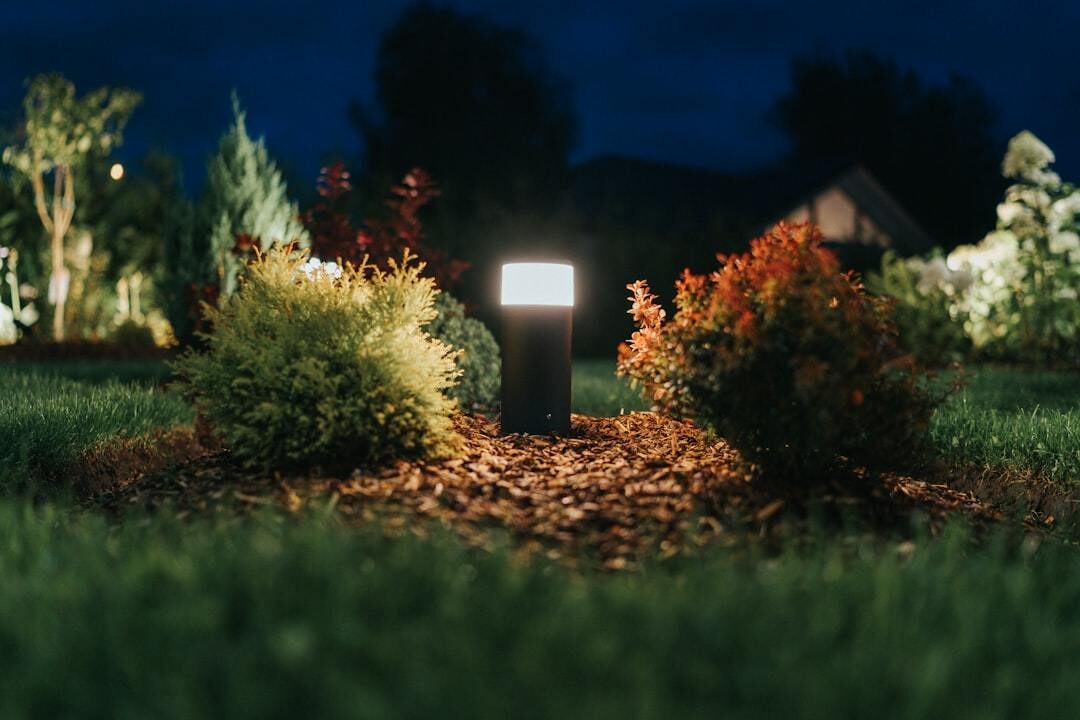Let’s dive straight into the heart of outdoor illumination: what is the best lumen for outdoor lights. This isn’t just about making your garden look pretty. It’s about choosing lighting that enhances safety, optimizes energy consumption, and transforms your outdoor space into a welcoming extension of your home. You’ll learn how lumens measure light output and why they’re key to comparing brightness across different lighting options. We’ll also explore efficient LED lights that give more bang for their buck compared to traditional bulbs.
In navigating through landscape lighting to floodlights, we’ll guide you on selecting the right lumen output for varied spaces—from cozy patios to sprawling backyards. Plus, get handy tips on installation and maximizing efficiency without jacking up your electricity bill. Our electricians in the Bucks County area are able to provide you the best installation for outdoor lighting in Doylestown surrounding area.
Understanding Lumens in Outdoor Lighting
What Are Lumens?
Lumens are the game changer when it comes to measuring light output. They tell us exactly how bright a bulb is, unlike watts that only measure energy consumption. This means choosing outdoor lighting isn’t about finding the highest wattage anymore; it’s all about those lumens. Imagine lumens as buckets of brightness – more buckets mean a brighter light.
This shift towards lumens has revolutionized our approach to outdoor lighting projects, making them not just more efficient but also allowing for precise customization according to our needs. Whether you’re illuminating a cozy backyard or securing your home against potential intruders, understanding lumens helps ensure adequate visibility without wasting energy.
LED vs. Traditional Bulbs
The battle between LED and traditional bulbs is akin to comparing an electric car with a gas guzzler in terms of efficiency. LED lights shine brightly in this arena, offering higher lumen outputs while consuming significantly less power than their incandescent counterparts.
A practical example would be considering an LED lamp of 10 watts providing as much visible light as a 43-watt halogen bulb. This stark difference highlights why LEDs have become the go-to choice for both indoor and outdoor spaces needing quality illumination at reduced electricity bills.
To sum up, by focusing on lumen output rather than wattage measures alone, we can make smarter choices for our exterior lighting design – opting for solutions that give us brighter lights with lower energy consumption rates.
Choosing LED over traditional bulbs not only ensures safety and visibility around your property but also plays into broader environmental sustainability goals by reducing overall electricity use.
This understanding marks the beginning of creating well-lit yet energetically economical outdoor areas tailored perfectly to one’s aesthetic preferences and functional requirements.
Lumens are your go-to for measuring brightness in outdoor lights, making it easy to pick efficient and bright options. LED wins over traditional bulbs by offering more light with less power, helping you save on bills and keep spaces well-lit.
Selecting the Right Lumen Output for Different Outdoor Areas
What Are Lumens?
Lumens are essentially the amount of light you get from a bulb. Imagine it as the brightness level your eyes perceive outside, not just how much electricity a bulb eats up. This is why lumens have become a crucial part in planning outdoor lighting projects.
In comparing LED lights to traditional bulbs, LEDs steal the show by providing higher lumens with less energy consumption. It’s like getting more bang for your buck but with brightness instead of explosions.
LED vs. Traditional Bulbs
When it comes down to choosing between LED and traditional bulbs for outdoor spaces, LEDs win hands-down because they give us more light per wattage used. Think about an LED lamp that only needs 10 watts to shine as brightly as a 43-watt halogen bulb—that’s energy efficiency at its finest.
This makes LEDs not only better for our wallets over time but also kinder to our planet since they use less power and last longer than their incandescent counterparts.
Landscape Lighting
If you’re illuminating pathways or gardens, path lighting typically requires around 100-200 lumens to ensure adequate visibility without overpowering natural night beauty. Floodlights meant for larger areas need beefier specs—think within the range of 700-1300 lumens—to effectively ward off potential intruders or simply make sure no one trips over garden gnomes at night.
Flood Lights & Step Lights
Flood lights are ideal when you’re looking to highlight certain features or need stronger illumination across large expanses like driveways; here’s where those higher lumen counts really come into play. Meanwhile, step lights require subtler luminosity (about 12-100 lumens) so steps are visible without being blindingly bright.
Pool Lighting
Around pools and water features, balancing safety with aesthetics means aiming for pool area lighting in the sweet spot between 200-400 lumens—a glow that ensures everyone sees where they’re stepping without turning nighttime swims into daylight experiences.
For anyone diving headfirst into DIY exterior lighting design or working alongside professionals, this guide on efficient lighting options from Energy.gov could be immensely helpful in making informed decisions based on both aesthetic preferences and practical considerations such as reducing electricity bills through smart energy consumption choices.
LED lights outshine traditional bulbs for outdoor areas by offering more light with less energy, making them both cost-effective and eco-friendly. From path to pool lighting, choosing the right lumen output enhances safety and beauty without wasting power.
Factors Influencing Outdoor Lighting Choices
Design Considerations
When it comes to sprucing up your outdoor space, the design of your lighting fixtures plays a huge role. It’s not just about throwing in some landscape lights and calling it a day. You want to create an ambiance that complements your home’s aesthetic while also meeting practical needs. For example, sleek LED pathway lighting can add a modern touch and guide guests safely to your door, whereas ornate lanterns might better suit a more traditional exterior.
The choice between different types of lights like security lights or decorative step lights should align with both the style and function you desire for your outdoor areas. Plus, considering how these fixtures blend with natural elements during daylight hours is crucial—after all, they’re visible then too.
Energy Consumption and Efficiency
In today’s world, energy efficiency isn’t just nice-to-have; it’s essential for reducing electricity bills and conserving resources. That’s where LEDs come into play—they’re real game-changers in terms of lumens per wattage measures compared to incandescent bulbs.
An LED lamp capable of providing as much light as a 43-watt halogen bulb only consumes around 10 watts—a fact worth celebrating if you enjoy having well-lit outdoor spaces without cringing at the energy bill each month. Not only do these choices affect our wallets but they also impact our planet by lessening overall energy consumption.
This makes selecting light sources that maximize lumen output while minimizing power usage critical when choosing outdoor lighting options for large areas or even cozy nooks like small patios or pool areas. By prioritizing high-efficiency LEDs over traditional options, homeowners can ensure adequate illumination that deters potential intruders without contributing excessively to light pollution—an important consideration for maintaining starry night skies above.
Making informed decisions about exterior lighting involves balancing aesthetics with functionality—and let’s not forget sustainability. From enhancing curb appeal through thoughtful landscape design considerations to optimizing luminosity versus energy expenditure via efficient LED technology, understanding these factors will help illuminate the path towards creating beautiful yet practical outdoor environments. Whether illuminating expansive landscapes or intimate gathering spots, embracing this holistic approach ensures safety alongside serenity under stars—or cityscape alike.
Boost your outdoor space by balancing style, safety, and sustainability. Choose LED lights for efficiency and design that matches your home’s vibe to light up safely without breaking the bank or harming the planet.
Installation Tips for Outdoor Lighting Fixtures
If you’re planning to enhance your outdoor space with lighting, knowing how to properly install various types of fixtures can make all the difference. From pathway lighting that guides you and your guests through your garden after dusk, to general outdoor lights that illuminate your patio or porch, each type requires a different approach.
Pathway Lighting Installation
When installing pathway lighting, placement is key. These lights should be spaced evenly along both sides of the path but staggered in an alternating pattern for optimal visibility and aesthetic appeal. This setup not only ensures safety by illuminating walkways but also adds a welcoming ambiance to any exterior space. To get started on installation, map out where each light will go before digging any holes or laying down wiring.
Digging shallow trenches for the wires and ensuring they are covered adequately prevents tripping hazards and protects the wiring from being damaged by lawn care equipment or foot traffic. Remember: low-voltage systems are ideal for pathway lighting because they’re safer to work with and consume less energy than their high-voltage counterparts.
Flood Lights & Security Features
Flood lights require careful consideration regarding placement since their purpose is twofold: illuminating large areas effectively while deterring potential intruders. Ideally, these should be mounted at a height—typically between 8-12 feet—to cast wide beams of light across open spaces without causing light pollution in neighboring properties.
To maximize security benefits without skyrocketing electricity bills, choose LED bulbs which provide brighter light at lower wattage compared to traditional incandescent bulbs. Additionally, consider motion sensors as part of the floodlight system; this way lights turn on automatically when activity is detected thereby enhancing security while conserving energy during periods of inactivity.
The Right Tools Make All The Difference
Honestly? Don’t skimp on quality tools—it’ll save you headaches later. For most installations, you’ll need:
- A drill with various bits appropriate for surfaces like wood, masonry, or drywall.
- Wire strippers and crimpers for electrical connections.
- Anchors and screws suited for mounting hardware depending on surface material.
Properly installed outdoor lighting not only enhances safety but also brings out beauty into nighttime views. By following these tips, you’ll ensure reliable performance from your outdoor fixtures year-round. Whether it’s soft path lights creating inviting walkways or powerful floodlights adding layers of security, outdoor illumination transforms spaces – making them usable and enjoyable, no matter what time it is.
Light up your outdoor space right. Space pathway lights evenly for safety and style, mount floodlights high to cover large areas without bothering the neighbors, and always go for LED with motion sensors to save energy. Don’t forget: quality tools are worth every penny.
Comparing Light Sources for Outdoor Use
Understanding Lumens in Outdoor Lighting
Lumens are the stars of the lighting world, telling us exactly how bright our outdoor spaces can shine. This measure of light output is crucial when deciding between LED bulbs and incandescent bulbs for your garden or porch. Imagine trying to choose a runner without knowing their speed; that’s what picking lights without considering lumens feels like.
With LEDs leading the charge in efficiency, it’s no surprise they’re preferred for outdoor settings. An impressive feat is how an LED lamp requiring only 10 watts can outshine a 43-watt halogen bulb. This isn’t just good news; it’s great news because it means we get more light with less energy—a win-win situation if there ever was one.
The secret sauce behind LEDs’ success lies in their ability to convert electricity into visible light far more effectively than their incandescent counterparts. So, when you’re illuminating large areas like driveways or focusing on smaller spots such as pathway lighting, choosing LED means opting for brilliance without burning through your wallet.
Selecting the Right Lumen Output for Different Outdoor Areas
Different strokes for different folks—or should we say different lumens for different rooms? Not all outdoor spaces demand the same level of brightness. Pathways cozy up nicely with anything from 100-200 lumens while floodlights guarding against potential intruders need to pack a punch at around 700-1300 lumens.
Your steps don’t require the sun’s intensity either; a modest range of 12-100 lumens will do just fine here, ensuring safety without blinding anyone. As for pool areas aiming to merge ambiance with visibility after dusk falls? A sweet spot exists between 200-400 lumens—enough to keep things lively and safe.
Factors Influencing Outdoor Lighting Choices
Beyond sheer brightness and power savings lie other considerations shaping our decisions around exterior illumination—the design being paramount among them. Energy-efficient options not only reduce bills but also cater to aesthetics, drawing together functionality and flair seamlessly within our outdoor havens.
Lumens measure brightness, making them key when choosing outdoor lights. LEDs offer more light for less energy, perfect for any space. Different areas need different lumens; pathways glow with 100-200 while floodlights shine at 700-1300. Energy efficiency and design also guide our lighting choices.
Maximizing Lumen Output While Minimizing Energy Use
Striking the perfect balance between bright outdoor lighting and low energy consumption can feel like a magic trick. But with today’s LED technology, it’s more science than sorcery.
Explores strategies for achieving bright and efficient outdoor illumination without increasing electricity bills significantly
To achieve this, understanding lumens is key. Lumens measure light output, making them essential for comparing the brightness of different lighting options. An LED lamp that uses just 10 watts can provide as much light as a 43-watt halogen bulb. This means you get the same brightness but save on your electricity bill because LEDs are more efficient at converting electricity into visible light compared to incandescent bulbs.
This efficiency doesn’t just save energy; it ensures that your outdoor spaces are well-lit without contributing excessively to light pollution—a win-win for both homeowners and Mother Nature.
Saves energy while ensuring safety in outdoor areas
Lumens ensure not only aesthetic appeal but also security by deterring potential intruders with well-lit exteriors. To choose led lights effectively, consider their lumen count rather than wattage measures since lumens measure brightness directly while wattage measures power consumption.
Selecting high-lumen outputs for large areas or places requiring brighter light—like floodlights over driveways—and lower lumens for smaller or intimate spaces such as path lights helps maintain balance between visibility and coziness without ramping up your utility costs.
Achieving optimal lighting intensity with strategic installation
Focusing on specific areas where higher levels of visibility are necessary is crucial in maximizing efficiency. For example, landscape lighting might require varying levels of luminosity: pathway lighting could need anywhere from 100-200 lumens whereas pool areas benefit from 200-400 lumens depending on size and desired effect. By targeting these installations strategically around your property based on needs assessment regarding lumen output versus energy consumption—you create an exterior space that’s both invitingly lit and environmentally conscious.
In essence, mastering the art of balancing bright yet cost-effective outdoor illumination boils down to informed choices about fixtures’ placement combined with leveraging modern LED solutions known for their superior lumen-to-watt ratio—an approach bound to illuminate paths (quite literally) towards sustainability goals alongside enhancing home security and curb appeal.
LED technology is the secret to bright, energy-efficient outdoor lighting. Understand lumens for optimal brightness without high costs, balancing visibility and ambiance while being eco-friendly.
Conclusion
So, what is the best lumen for outdoor lights? It all boils down to purpose and place. For cozy patios, think smaller lumens; sprawling yards demand more.
Lumens light up your decision-making process. They let you compare brightness like a pro. Choosing LED means choosing efficiency—a win for both brilliance and bills.
Picking the right output isn’t just smart; it’s strategic. From pathways needing a gentle glow to floodlights warding off potential intruders, every lumen counts.
Installation insights pave the way for safety and ambiance alike. And remember, maximizing lumens while minimizing energy isn’t just possible—it’s practical.
In sum: Let lumens lead your lighting choices—from design through installation—to ensure that each corner of your outdoor space shines perfectly without draining resources or dimming beauty. Give QG Smart Home a call to learn more about our landscape lighting in Montgomery County, PA surrounding area.










